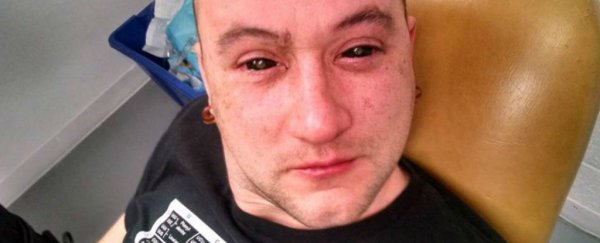Back in 2015, a team of biochemical researchers in the US figured out how to give a human volunteer night vision, allowing him to see across a distance of over 50 metres in total darkness for several hours.
The key is a natural, light-sensitive substance called Chlorin e6 (Ce6), which is derived from sea creatures and has been used for many years in cancer treatment research.
It's also been shown to be effective in the treatment of night blindness and improving dim light vision in people with eye disorders, so an independent team of self-described 'bio-hackers' in California called Science for the Masses decided to see how else it could be used to improve vision.
The idea came from a patent filed in 2012, claiming that when you apply a mixture of Ce6, insulin, and saline to a person's eye, the retina will absorb it and increase vision in low light.
The patent also mentions that the chemical dimethlysulfoxide (DMSO) can be used in place of the insulin, but the Science for the Masses team thought, why not use both to increase the permeability of the solution?
"Going off that research, we thought this would be something to move ahead with," the lab's medical officer, Jeffrey Tibbetts, told Max Plenke at Mic.
"There are a fair amount of papers talking about having it injected in models like rats, and it's been used intravenously since the '60s as a treatment for different cancers. After doing the research, you have to take the next step."
Fellow researcher, Gabriel Licina (pictured above), stepped forward to be their human guinea pig. The team explains the procedure over at their website:
"For the application, the subject rested supine and his eyes were flushed with saline to remove any micro-debris or contaminants that might be present.
Eyes were pinned open with a small speculum to remove the potential for blinking, which may force excess liquid out before it had a chance to absorb. Ce6 solution was added to the conjunctival sac via micropippette at 3 doses of 50μl into each eye.
After each application, pressure was applied to the canthus to stop liquid from moving from the eye to the nasal region. Each dose was allowed to absorb between reloading the pippette, with the black colour disappearing after only a few seconds.
After application was complete, the speculum was removed and black sclera lenses were placed into each eye to reduce the potential light entering the eye.
Black sunglasses were then worn during all but testing, to ensure increased low light conditions and reduce the potential for bright light exposure."
Licina reported experiencing the effects for "many hours" after application, the team reports.
Licina and four controls were then placed in a dark environment, and Licina waited to feel the effects. After about an hour, he started to make out the objects of shapes in the darkness about 10 metres away.
Soon, this distance progressed to 20, and eventually just over 50 metres, with Licina able to recognise and identify symbols and objects, such as numbers, letters, and shapes, moving against differently coloured and patterned backgrounds.
Licina and the controls were tested on how many they could identify. And we're not talking huge objects here, Licina told Mic they were about the size of his hand.
Next, Licina and the controls were taken out into the woods at night and moved into separate locations. Then they were asked to try and spot people standing in random locations 50 metres away. The team reports the results, and they're pretty phenomenal:
"The Ce6 subject and controls were handed a laser pointer and asked to identify the location of the people in the grove. After testing, the Ce6 subject replaced the sunglasses, which were not removed until sleep.
Eyesight in the morning seemed to have returned to normal and as of 20 days, there have been no noticeable effects.
The Ce6 subject consistently recognised symbols that did not seem to be visible to the controls. The Ce6 subject identified the distant figures 100 percent of the time, with the controls showing a 33 percent identification rate."
The team recognises that a lot more testing needs to be done, but they say that this can be done cheaply, because the substances are inexpensive, and have already been rigorously tested for human safety for other applications.
They told Max Plenke at Mic that the whole idea behind their research group is to pursue the things that major corporations or research institutions wouldn't bother with, but are too fascinating to ignore.
"For us, it comes down to pursuing things that are doable but won't be pursued by major corporations," said Tibbetts. "There are rules to be followed and don't go crazy, but science isn't a mystical language that only a few elite people can speak."
Crazy, but kind of amazing.
A version of this article was originally published in March 2015.
